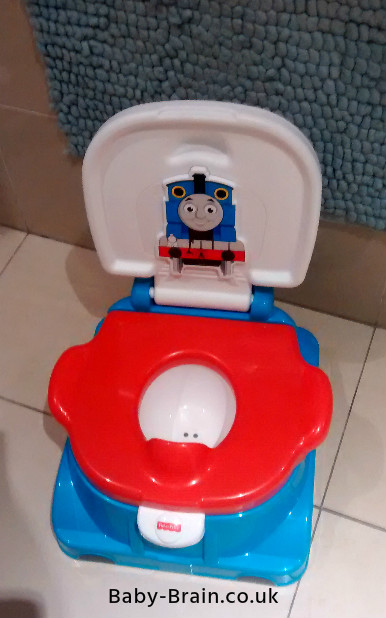…

Our potty
The potty “training” still seems to be going well. I say “training” because I feel like we’re not specifically doing anything, but then I looked back on what we had set up, and, actually I can think some psychological and “set-up” aspects apply.
Firstly, we upgraded the basic boring plastic potty we had previously (that he never sat on) to a fancy Thomas the Tank Engine colourful potty that plays a little song when something is deposited in it. This is a reward in itself. We made the potty interesting and something exciting to sit on by selecting one where he recognises the theme (Thomas), and likes and potentially trusts that brand (because he likes the toy). We set it up so that it wasn’t a toy, though, so he knows there’s a particular function around it. We started to talk more about that “function” and make it part of our every day, normal, conversation by saying things like “mummy is going to the big potty now”, etc, to make the toddler aware that going on the potty is a normal thing people do. I suppose we kind of set up a graded step by step hierarchy as well by:
-
Introducing the potty
-
Having the potty out in the living room
-
Discussing that the potty is for doing a wee or poo in, not a toy, and normalizing this process when adults in the house needed to go to the “big potty”
-
Encouraging the toddler to sit on the potty, with clothes on in the first instance (as he wasn’t sure about it)
-
offering a reward/reinforcement for just sitting on it (I can’t remember if this was a biscuit or watching his favourite TV show, which also probably reduced any anxiety or concerns because he was distracted by the TV and calmed by his favourite show)
-
-
Encouraging the toddler to sit on the potty without a nappy (diaper) on
-
Encouraging him to sit on it when we thought he might need a wee, e.g. after a bath because that’s when he often does one, and offering a reward for doing a wee – also talking about what reward he would get
-
offering a reward/reinforcement for doing a wee which was chocolate and now also a reward “coupon”, which the toddler calls “tickets”. He likes the fire engine tickets the most (pictured)
-

Reward “coupon”
We haven’t got to the point yet where the toddler can tell us that he feels the need to use the potty. That is still to come. But, we’ve done very well so far I think!
♦♦♦♦♦♦♦♦♦♦♦♦♦♦♦♦♦♦♦♦♦♦♦
Also, here’s a complete cut and paste job from a previous post of mine about reinforcement:
Ψ reinforcers = increase frequency/likelihood of a behaviour
Ψ punishers = decrease frequency/likelihood of a behaviour
Ψ Here’s a good page that explains positive/negative reinforcement and punishers – for example, they explain that “punishment” doesn’t necessarily mean there is a harmful or dangerous consequence, it’s a process where a consequence immediately follows a behaviour which decreases the future likelihood of that behaviour occurring. Positive punishment is where a negative consequence is put in place after the behaviour, like sending child to “time out” or telling them off, and negative punishment where a good thing or desired outcome is removed after the behaviour occurs, such as removing cake/sweets/ice cream because the child was “naughty”. Reinforcement is where behaviour increases. Positive reinforcement is where a behaviour increases because it’s followed by a positive/motivating consequence such as praise, reward, like giving a kid money (positive) for doing chores (the behaviour). Negative reinforcement is where behaviour increases because a negative consequence is removed, such as a kid does his chores (behaviour) to avoid being nagged to do it (negative).
